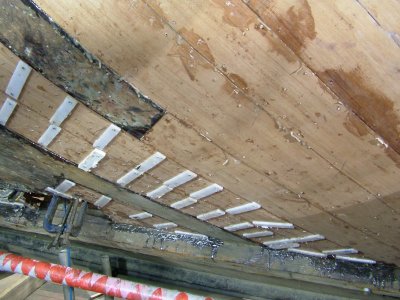
Traditional Woodworking - Part Two

When the William Riley arrived back in Whitby its hull breaches were unsightly to look at, even when the hull was cleaned up with all the debris removed they were a constant reminder of just how bad the hull integrity was. As a double diagonal planked hull, effecting a suitable repair was always going to be the domain of someone professionally skilled in using traditional boat building methods, willing to take on such a demanding job. The trust looked within the town for a suitably qualified person calling upon Michael Coates (not the Canadian born saxophonist).
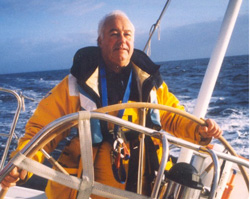
Mike is the skipper / owner of the Jolly Swagman, a cutter rigged Hans Christian 43T (Traditional) designed for long ocean passage making. Mike (left)at the helm of the 67 foot Challenge yacht 'Isle of Man', attempting a December voyage to the famed Fastnet Rock. Mike has skippered keelboats, yachts from racing through to ocean going and made power and sailboat deliveries throughout Europe leaving him with extensive cruising knowledge of Scandinavia including, Norway, Sweden and Denmark. Mike was also a member of the local lifeboat crew serving for 20 years, first as a crewman on the inshore lifeboat, then on the offshore lifeboat, eventually attaining the position of 2nd coxswain. In 1987 he attended the US Coastguard Heavy Weather School in Washington State USA (The Surfman School featured on Discovery Channel) graduating with the qualification of `US Dept of Transportation Heavy Weather Lifeboat Coxswain’.
Mike's grounding in how traditional craft were constructed began as an helper at the local boatyard, in 1972 Mike and his wife Yvonne, opened their own marine business and boatyard building, repairing and rigging all types of dinghies. With increased demand they moved into larger premises allowing the facility to service, repair and build larger vessels, with the addition of a dedicated spar and rigging shop. This was simply the beginning of a long prosperous career, in which "Coates Marine" synonymous with quality traditional marine services.
William Riley
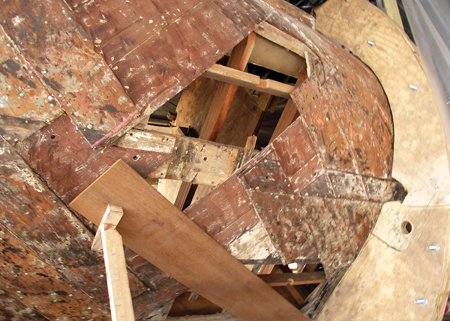
Mike needed no introduction to the problems of the boat's double planking as he had done extensive repairs to the hull of the Mary Ann Hepworth, another of Whitby's former lifeboats. Given his skills the trust was grateful for his willingness to become one of the many people involved with the project not only sharing his skills and knowledge as a traditional boat builder, but also in offering a significant discount on his normal rates.
The main breaches on the William Riley happened to be placed almost centrally amidships and if we did not have the capacity to invert the hull it would have certainly been an uncomfortable task of repairing the breaches. Mike started by removing the timber surrounding the holes, taking this away until he reached sound timber. It was once this was done that the full extent of the hull breaches could be seen for what they were. It was quite startling to see the work that was needed and just how important it was to have a skilled craftsmen doing the work. I am not really able to do the work justice here because of the amount of work required. However, I will do my best to display a selection of photographs to give some idea of the demanding work and skill involved.
It may be worth noting that Mike was unable to obtain 4mm & 5mm Khaya mahogany veneer so that he could put down 2 layers of 4mm for the inside planking to make up the 8mm & 2 layers of 5mm for the outside planking. Unfortunately the suppliers in Germany, who supplied the UK went out of business & no one produced this thickness, he therefore had to use what was available which was 3mm & 2mm meaning an extra layer had to be used to make up the thickness of each plank resulting in an extra millimetre that had to be planed off the finished outer planking. On top of all this, each plank had to have epoxy glue reinforced with micro fibre filler applied to both it and also the plank it was being glued to, to ensure a fully wetted out joint.
With the old wood removed Mike was able to begin adding strips of laminate, although held in place by a number of clamps the effect was almost immediate. The second of the two photographs illustrates how the laminates were used to build up the missing planking.
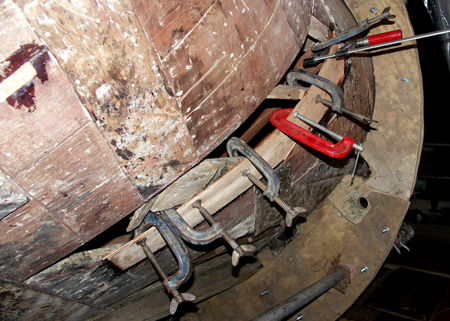 |
 |
Mike took time out to capture his own photographs, the following five are from his own collection.
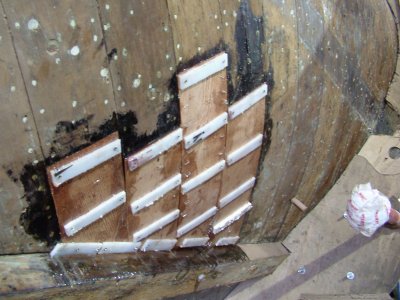 |
 |
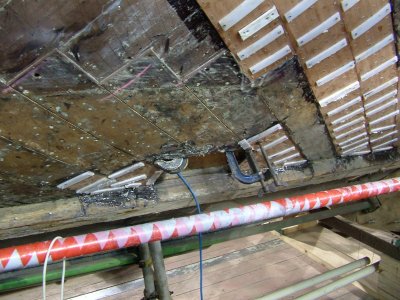 |
 |
© Michael Coates |
By this stage quite a few laminates have been placed at opposing angles to the lower layer to gain the strength required in the 'double planking', held in place with small plastic clamps.
 |
 |
With the plastic pieces holding the laminates in place removed Mike set about fine tuning the work. Small amounts of filler is added to fill any minor imperfections, expected with a boat of this age. Once everything had been left to cure and harden Mike was faced with planing off the extra millimetre and sanding the filler to match the surrounding timber.
 |
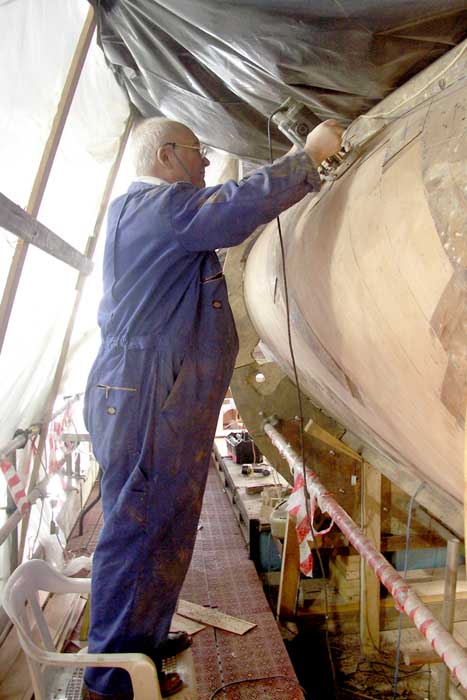 |
Looking at the pictures through these two pages creates the impression that once you have fitted a plank in to position against an existing one it would then be a simple matter of butting the edge of the next up to it, this is where the skill lies & where a novice without the knowledge & some training will fail. The plank edge has to be `spiled’ to shape. Before a plank is bent round the hull when laid flat its edge is straight, when it is bent round the curve of the hull this straight edge becomes a curve, therefore the edge of the plank to be fitted against it has to have a curve cut into it to match the curve of the plank it has to butt against. You can actually force the straight edge of a plank against the one previously fitted but this may result in bulges forming along the plank!
Follow this link to see more of Mikes delicate work equally well illustrated.
Copyright © Colin Brittain 1999 - 2022
